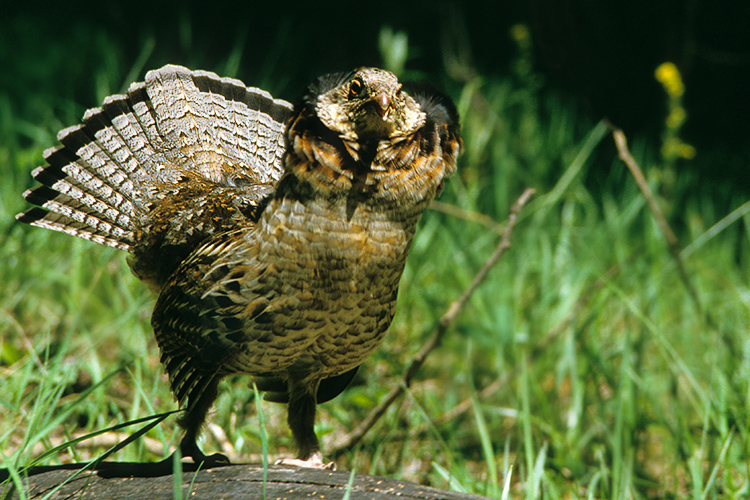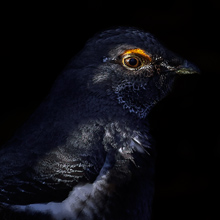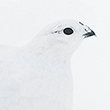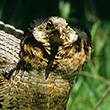
Availability: Undetermined - Enquiries?
In the Field
Ruffed Grouse Courting. Sheep River Wildlife Sanctuary, AB, Canada. June 25, 1984.
Another ancient shot from the archives! I've included this shot to make a few points: don't be afraid to dust off those old slides and give them a second look. There may be gold lurking in the shadows of those slides!
As is obvious from the strong shadow cast by this grouse's bill, this scene was strongly toplit. In the original slide the bird's chest and underbelly were in extreme shade and appeared almost black. The representation of the scene by the slide was far more contrasty and with stronger shadows than it looked to the naked eye. This is because film (ALL film) can capture a much smaller range of brightness (or dynamic range) than can the human eye. In this case I scanned the slide and then used a few "tricks" in Photoshop CS2 to recover the nearly lost shadow detail. The final corrected image ended up being much closer to "reality" than was the original slide. By the way, I didn't touch the shadow cast by the bill (I could have lightened it significantly) simply because I knew it would help me describe the shooting situation and explain the dynamic range issue.
Behind the Camera
Ruffed Grouse Courting. Sheep River Wildlife Sanctuary, AB, Canada. June 25, 1984.
Film Capture; Fujichrome 100; ISO 100.
Minolta X-700 film SLR with 300 mm Rokkor-X F4.5 lens - handheld.
Exposure information not recorded.
At the Computer
Ruffed Grouse Courting. Sheep River Wildlife Sanctuary, AB, Canada. June 25, 1984.
Details to follow.
Conservation
Ruffed Grouse Courting. Sheep River Wildlife Sanctuary, AB, Canada. June 25, 1984.
Species Status in Canada*: This species is not designated as at risk.
The Ruffed Grouse (Bonasa umbellus) is widely distributed in both deciduous and coniferous forests of North America. It normally has a highly cryptic plumage of mottled gray, brown, buff, and black coloration and it blends in well with its surroundings in months without snow cover.
Ruffed Grouse are avidly hunted and, consequently, harvests are monitored and controlled by bag limits, season lengths, and area closures. However, most mortality in Ruffed Grouse is caused by predators. Regular and synchronous irruptions of predators in Alaska and Canada are caused by the dramatic 8- to 11-year cycle in numbers of snowshoe hares (Lepus americanus). Scarcity of hares produces heavy predation on sympatric Ruffed Grouse and emigration of hungry predators.
Populations of Ruffed Grouse are probably stable in Canada and the western US, but declining in the eastern US.
*as determined by COSEWIC: The Committee on the Status of Endangered Wildlife in Canada























